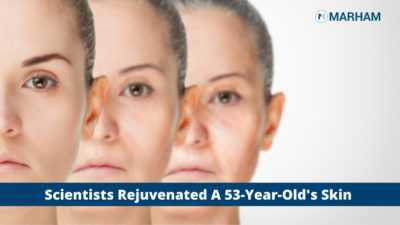Thursday (7th April, 2022): Cambridge: According to Scientists at Babraham Institute in Cambridge, they have successfully rejuvenated a 53-Year-Old’s skin cells to look like a 23 year old.
Who doesn’t want to have skin as young as 20 years old? Wrinkle-free skin is a dream of every woman. But this miracle is not a dream anymore. Because scientists have rejuvenated the aged skin cells into younger looking cells, according to the press release.
A team of scientists at Babraham Institute in Cambridge did a successful experiment to turn aged skin cells into young skin cells. The researchers announced this fantastic achievement the last Thursday.
Using adult cells, the scientists set out to produce embryonic stem cells, which can divide into any type of cell in the body. This helps in making cells that look like young adults.
Shinya Yamanaka, a noble prize laureate and a researcher at Kyoto University in Japan, was the first to convert “normal” cells with a specified function into stem cells in 2006. Yamanaka developed iPS stem cells by exposing adult cells to four molecules for around 50 days. Reik and Gill alongwith their teammates exposed skin cells to the same molecules for only 13 days and then let them grow in natural conditions.
According to the BBC, Wolf Reik, a German molecular scientist, postdoctoral student Diljeet Gill, and a team at the Babraham Institute expanded on Yamanaka’s findings.
Scientists have found age-related alterations in skin cells. They can remove and lose their identity temporarily. This study was done by monitoring collagen formation in the cells. After growing under normal circumstances for a while, researchers discovered that the cells began to behave like skin cells again.
Dr. Diljeet Gill, a postdoctoral researcher in Prof Reik’s group at the Babraham Institute and Ph.D. student, carried out this research with his team. According to a press statement from Gill, the researchers assessed age-related biological changes in the reprogrammed cells. They discovered that the cells matched the profile of people 30 years younger to reference data sets.
Gill told BBC;
“I remember the day I got the results back, and I didn’t quite believe that some of the cells were 30 years younger than they were supposed to be; it was a very exciting day.”
On April 8, the researchers’ findings were published in the journal eLife.
Reik told the BBC that the team would not be able to use the technique in a clinic because the method used to rejuvenate the cells has the potential to increase the risk of cancer, most likely due to the creation of permanent genetic changes within cells. That’s why the study was only conducted in a laboratory at this time.
But this research is a miracle and a blessing for humanity. Scientist believes that the approach of regenerating cells might help burn victims heal faster and may eventually benefit human life.
Reik said in a press release;
“Eventually, we may be able to identify genes that rejuvenate without reprogramming, and specifically target those to reduce the effects of aging.”
This research is an actual achievement for many skin problems, and it can help in the production of many skin products. Scientists have devised a mechanism to leap three decades in time in human skin cells.
According to scientists, these studies will also help treat other age-related diseases like Alzheimer’s, cataracts, etc.
For further information related to age related skin issues and their treatment, you can consult the best dermatologists in Pakistan. You can book an appointment with the best health specialists through Marham by calling the Marham helpline: 0311-1222398 or by online booking facility through the website or Marham mobile app.
| Android | IOS |
|---|---|
  |
  |

